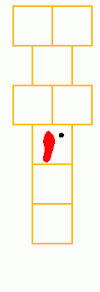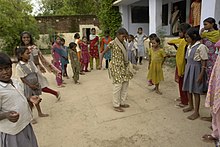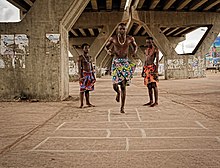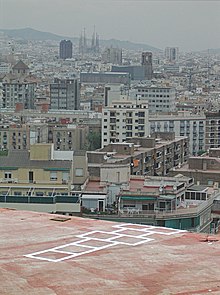Draw Chalk Boxes on the Ground Game Name
 Master schoolchildren hopscotching in Republic of cuba, where the game is known equally "pon" |

Moves in a Hungarian hopscotch (blackness dot existence the stone, bandage and retrieved
Hopscotch is a pop playground game in which players toss a modest object, called a lagger,[1] [2] into numbered triangles or a pattern of rectangles outlined on the ground and then hop or bound through the spaces and call up the object.[3] It is a children'south game that can exist played with several players or solitary. Hopscotch is the predecessor of seated hopscotch board games such as Go, Chess, Checkers.[4] Hopscotch is concrete and cognitive workout.[5] [half dozen] [7]
Court and rules [edit]

Marelle (french)
schoolyard court

English

English language (simple)

American
The court [edit]
To play hopscotch, a courtroom is first laid out on the ground. Depending on the bachelor surface, the court is either scratched out in the dirt or fatigued with chalk on pavement. Courts may exist permanently marked where playgrounds are usually paved, as in elementary schools. Designs vary, but the court is usually composed of a serial of linear squares interspersed with blocks of two lateral squares. Traditionally the court ends with a "prophylactic" or "dwelling house" base in which the player may plough before completing the opposite trip. The home base of operations may be a square, a rectangle, or a semicircle. The squares are then numbered in the sequence in which they are to exist hopped.
Playing the game [edit]
The showtime player tosses a marker, likewise called a "lucky edible bean", onto the court.[9] [10] The marker (typically a small stone, money, bean bag, or small chain with a charm) should land in the square without bouncing, sliding, or rolling out. (In Ireland, the marking is usually replaced with an one-time shoe polish tin or flat stone, called a piggy.[ citation needed ]) In the United States the mark was called a "lagger" and in the 1940s Hopscotch Laggers made of rubber were sold by the Hoppy Taw Company of Utah.[11] The marker must exist thrown in sequential numerical club completely within the foursquare without touching the line.[12] The role player then hops through the course, skipping the marker's square. Single squares must exist hopped on ane foot, except for the first single square, where either foot may exist used. Side-by-side squares are straddled, with the left foot landing in the left square, and the correct pes landing in the right foursquare. Optional squares marked "Rubber", "Home", or "Rest" are neutral squares, and may be hopped through in whatsoever manner without penalty. Later on hopping into "Safe", "Home", or "Rest", the player must then turn around and retrace their steps through the course on one or ii legs, depending on the square, until reaching the marker'south square. The player stops in the foursquare before the marker[13] [14] [xv] and reaches down to retrieve the mark and continue the course as stated, without touching a line or stepping into a square with some other player's marker.
Upon successfully completing the sequence, the player continues the turn past tossing the marker into square number ii, and repeating the pattern.
If, while hopping through the courtroom in either direction, the actor steps on a line, misses a square, or loses residual, the turn ends. Players begin their turns where they last left off. The showtime player to complete ane course for every numbered square on the court wins the game.
Although the marker is most frequently picked up during the game, historically, in the boy'due south game, the marker was kicked sequentially back through the course on the return trip and so kicked out.[16]
Origin [edit]

Hopscotch is attested, in Chinese texts as early on as 2357 B.C.,[4] and c.1200 to 600–500 BCE, from Painted Grey ware era of prehistoric Bharat,[17] it is also listed amid the games prohibited by Buddha. It is attested that an ancient grade of hopscotch was played by Roman children and soldiers,[18] [19] [20] but the first recorded references to the game in the English-speaking world date to the late seventeenth century, usually under the name "scotch-hop" or "scotch-hopper(southward)".[21] A manuscript Book of Games compiled between 1635 and 1672 by Francis Willughby refers to 'Scotch Hopper‥. They play with a piece of tile or a little flat piece of lead, upon a boarded flooring, or any surface area divided into ellipsoidal figures similar boards'.[22] In Poor Robin's Almanack for 1677, the game is referred to as "Scotch-hoppers". The entry states, "The time when schoolboys should play at Scotch-hoppers." The 1707 edition of Poor Robin's Almanack includes the following phrase… "Lawyers and Physicians have picayune to practise this month, so they may (if they volition) play at Scotch-hoppers."[23] In 1828, Webster's American Dictionary of the English Linguistic communication too referred to the game as 'Scotch-hopper' ... 'a play in which boys hop over scotches and lines in the footing.'[24]
Etymology [edit]
According to the Oxford English Dictionary, the etymology of hopscotch is a formation from the words "hop" and "scotch", the latter in the sense of "an incised line or scratch".[25] The journal of the British Archaeological Clan, volume 26 (dated March 9, 1870) states: "The sport of Hop-Scotch or Scotch-Hoppers is called in Yorkshire 'Hop-Score', and in Suffolk 'Scotch Hobbies or Hobby', from the boy who gets on the player'southward back whilst hopping or 'hicking', every bit it is in that location termed; and in Scotland it is known every bit 'Peevers, Peeverels, and Pabats'".
Czechs can experience the give-and-take as a Bohemism because skoč is a Czech imperative of skočit = "jump", and "hop" is commonly used equally an interjection of jumping.
Variations [edit]

There are many other forms of hopscotch played across the earth.[26] In India it is called Stapu or Kit Kit in Hindi, Nondi (Tamil), Thokkudu billa (Telugu) or Kith-Kith, in Kingdom of spain and some Latin American countries, information technology is chosen rayuela, although it may also be known as golosa or charranca. In France marelle is the proper name for the game. In Turkey, it is Seksek (from sek, "to hop"). In Russian it is known as классики (klássiki, diminutive for the word meaning "classes"). In Poland, it announced in 2 forms: klasy ("classes") which has a rectangular shape and no marking, instead, players call out names of diverse items of a given course, e.g. colours or flowers, while jumping on successive fields; and pajac ("buffoon") which has a human being shape and uses a thrown marker, e.g. a piece of glass or stone. In Sweden the game is named hoppa hage (lit. "jumping the garden"), while in Norway it is called paradis, or Paradise. In Italian republic the game is known equally campana (meaning "bell"), or mondo ("world"). In the netherlands and Flanders, information technology is called Hinkelen ("skip"). In Bosnia, Croatia, and Serbia information technology is called školica, significant "little school". In Malaysia, the most popular variant is called tengteng. In Mexico, it is called bebeleche (mamaleche) meaning "potable milk" or avioncito pregnant "little plane", after its shape. In Cuba and in Puerto Rico information technology is called "La Peregrina" (meaning "Pilgrim Girl") and the squares represent the nine rings the pilgrim traveler has to laissez passer in order to reach Heaven from Purgatory co-ordinate to Dante's Inferno. In Romania the game is called șotron and is widely played by children all over the state. In Kingdom of denmark it is called hopskok.[27] In Brazil it is called amarelinha, evolved from marelle, the French name for the game that became likewise closely associated with the radical amarelo (xanthous) and its diminutive in -inho/a. In Breton, the name is reg or delech. The Albanian variant is called rrasavi, which is equanimous of ii words: rrasa ("the apartment stone", an object used to play the game) and vi ("line", a reference to the lines that incorporate the diagram of the course). In China, hopscotch is chosen tiao fangzi (跳房子, meaning "jumping the houses"). In Philippines, hopscotch is called piko in Tagalog and sometimes also called kiki or Bikabix in Visayas/Cebuano. Its common court in the Philippines has six squares. In India, hopscotch is called "thikrya", because cleaved stones called thikrya are slid across the grid as players hop to each square. In South korea, hopscotch is called sabancchigi (사방치기, pregnant "Hit the Four Cardinal Directions") and is widely played across the nation. In Ghana, hopscotch is called "tumatu" and is mostly played by children.[28] In Zimbabwe, the game is called pada and its mostly played past girls. In America the game is referred to as Hop Scotch and is played with a marker. It is plant on elementary school playgrounds and is an activity most often played past girls.
Persian: Laylay (or Khane bazi) [edit]

Street mosaic in the shape of hopscotch game in Boston, USA
The hopscotch game'due south generic name in Persian is Laylay. The most common form of Laylay in Iran resembles the older Western types and uses six or more than (always an even number) side-by-side squares successively (vertically) numbered. The player uses a peg or a apartment stone that the histrion must kick to the next square equally the thespian is hopping. If either the rock or a player's human foot lands on a line, the player forfeits the game (or loses a turn). Although somewhat less common, the contemporary Western blazon also is played.
Glasgow: Peevers or Peever [edit]
In the Glasgow expanse, the hopscotch game is called "beds" or "Peever(s)". "Peever" is likewise the name of the object which is slid across the grid to land in a foursquare. In the 1950s and 1960s in Glasgow, information technology was common for the peever to be a shoe polish tin filled with stones or dirt and screwed close.[29] [30]
Edinburgh children likewise telephone call the game Peevers, played on a Peever bed with a chalked filigree and a small-scale flat tin can - like a puck, where the chalk is stored during the game with the ballast.
French: Marelle, Escargot [edit]
"Marelle" is the name of the traditional hopscotch game in France, but a variant there is known as escargot (snail) or marelle ronde (round hopscotch).[31] The variant is played on a screw course. Players must hop on 1 human foot to the centre of the spiral and then reverse their path to back out once more.
If the player reaches the middle without stepping on a line or losing remainder he or she marks one foursquare with his or her initials, and from then on may place two anxiety in that square, while all other players must hop over it. The game ends when all squares are marked or no ane tin can achieve the center and the winner is the player who "owns" the most squares.[32]
High german: Himmel und Hölle [edit]
In Frg, Republic of austria, and Switzerland the hopscotch game is called Himmel und Hölle (Heaven and Hell) although some other names are used, as well, depending on the region. The foursquare beneath 1 or the 1 itself, is called Erde (Earth) while the second to final square is the Hölle (Hell) and the concluding 1 is Himmel (Sky). The first role player throws a small stone into the first square and so jumps to the square and must kick the stone to the next square then on, withal, neither the stone nor the player may stop in Hell so they try to skip that square.
Bharat: Kith-Kith [edit]

In India, hopscotch is likewise called Kith-Kith, Stapu, Langdi in the Hindi-speaking areas, or Ekhaat Duhaat or Ekka Dukka in Bengal, Langdipani in Maharashtra, Kunte bille in Karnataka, Paandi in Tamil Nadu, and Tokkudu Billa in Andhra Pradesh and Telangana. These games take similar principles in that players must hop on one foot and must throw the mark in the right foursquare. The game is enjoying by kids throughout the country.
New York City: Potsy [edit]
Potsy is the proper name of a hopscotch game that was played in New York Metropolis. The name probably refers to a "potsherd" that was used equally a marker.[33]
Brazil: Amarelinha [edit]
In Brazil, this game is called Amarelinha.
Republic of chile: Luche [edit]
In Chile, this game is called Luche.
Australian hop scotch [edit]
In Commonwealth of australia, hopscotch is played in stages. The start stage is played by hopping per the standard rules. Once this stage is consummate, the player is promoted to the adjacent phase called "jumps" where the player jumps into each square with two feet. The concluding phase is the about difficult stage called "sizzles", which is similar to jumps except the legs are crossed. The commencement player to complete all three stages wins. If a player touches a line, he is demoted to the showtime of his current stage. For younger players, "helps" can exist used. These are lines typically extended at the sides between squares 2 and 3 so younger players can use these to get closer to throwing the "tortoise " into the required foursquare.[ citation needed ]
Latin America: Rayuela [edit]

Boys playing tumatu in Republic of ghana
In Argentine republic, Colombia, Costa rica, Ecuador, Guatemala, Honduras, Nicaragua, Panama, Uruguay, and Spain the name of the hopscotch game is "Rayuela",[34] but post-obit some cultural development, in Chile this name now is applied to a throwing game.[35]
Due south Asia: Chindro [edit]
Chindro is the South Asian version of hopscotch.
Catalonia: Xarranca [edit]
Xarranca is the Catalan version of hopscotch.
Ghana: Tumatu [edit]
In Republic of ghana, the name of the hopscotch game is tumatu.[28]
Longest design [edit]
During the COVID-xix pandemic, in April 2020 a behemothic hopscotch game with most ane,000 squares was created in Edinburgh, to be used while post-obit social distancing rules.[36] [37]
World tape [edit]
The electric current Guinness Book of Globe Records holder for the fastest hopscotch game is Ashrita Furman, at 1 minute and 8 seconds.[38]
In popular civilization [edit]

"Hopscotch to oblivion", Barcelona, Spain; an example of dark humour
- A hopscotch court drawn such that the surface area where the final step would exist is instead a sheer drop such as a building or cliff, such that any participant would fall to their death upon completion, is a motif occasionally seen in fiction, sometimes every bit a device for black comedy.
- A notable example is featured on the cover of the Korn anthology Follow the Leader, which focuses on a immature girl participating in the game at a cliff. The concept was described by Jonathan Davis as representing a loss of innocence.[39]
- A 2010 PBS documentary, New York Street Games, includes "potsy", described as a "girl'due south game" in the flick.[40]
- Julio Cortázar based his novel Hopscotch on this game.
See also [edit]
- Pachisi
- Timeline of chess
- History of chess
References [edit]
- ^ Baker, Kate (x January 2015). "Laggers". Kathleen, Kage and the Visitor . Retrieved xv March 2022.
- ^ Gold, David 50. (Spring 1981). "Three New-York-Cityisms: Sliding Pond, Potsy, and Akey". American Speech. 56 (1): 17. doi:10.2307/454476. JSTOR 454476.
In the 1950s, the game was called hopscotch and the object thrown a lagger /'lagar/. "Lagger" is related to the verb "lag"
- ^ "Definition of HOPSCOTCH". Merriam-Webster . Retrieved 15 March 2022.
a child's game in which a histrion tosses an object (such as a stone) into areas of a effigy outlined on the ground and hops through the figure and back to regain the object
- ^ a b "Hopscotch (Winning Eternal Life)". Toys & Games. Musée de la civilisation. Archived from the original on 27 September 2007. Retrieved 15 March 2022.
- ^ Mccarthy, Cheryl; Connell, Gill (twenty June 2012). "WHY HOPSCOTCH MATTERS". Moving Smart . Retrieved fifteen March 2022.
- ^ Welsh, Richard O. (June 2017). "School Hopscotch: A Comprehensive Review of Chiliad–12 Student Mobility in the United States". Review of Educational Enquiry. 87 (3): 475–511. doi:ten.3102/0034654316672068. Retrieved 15 March 2022.
- ^ Laely, Khusnul; Yudi, Dede (17 Dec 2018). "The Impact of Hopscotch Game towards the Growth of Kinesthetic Intelligence on 3-4 Twelvemonth Old Children". Early Childhood Inquiry Journal. 1 (1): 21–28. doi:10.23917/ecrj.v1i1.6581. Retrieved xv March 2022.
- ^ Bristles, D.C. (1907). The Outdoor Handy Volume: For the Playground, Field, and Woods. New York: Charles Scribner'southward Sons. pp. 356–357.
- ^ Salley, David P. "Hopscotch". Canisius Higher. Archived from the original on 28 January 1999. Retrieved fifteen March 2022.
Dagonell the Juggler
- ^ Whiteman, Susan (November 1, 2005). "Hopscotch History and Variation". University at Albany, SUNY . Retrieved 15 March 2022.
- ^ Hoppy Taw Hopscotch Lagger https://www.etsy.com/listing/105606102/lagger-hoppy-taw-hopscotch-game-thingie?show_sold_out_detail=1&ref=nla_listing_details
- ^ How To Play Hopscotch: Learn the Basic Rules and V Variations Parents Magazine https://www.parents.com/fun/activities/hopscotch/
- ^ "Hopscotch". Retrieved 2017-04-24 .
- ^ "Hopscotch". kidspot. NewsLifeMedia. Retrieved 2017-04-24 .
- ^ "Hopscotch Game". Fun Games Kids Play . Retrieved 2017-04-24 .
The two basic rules to remember - 1. Players tin can only have 1 foot in each square of the hopscotch board at a fourth dimension. 2. Players accept to hop over the square with the rock in it.
- ^ Chisholm, Hugh, ed. (1911). . Encyclopædia Britannica. Vol. 13 (11th ed.). Cambridge University Printing. p. 687.
- ^ Lal, B.B. "The Painted Greyness Ware culture of the Atomic number 26 age" (PDF). Silk Road. I: 412–431.
- ^ Schädler, Ulrich (1 April 2021). "Some Misconceptions About Ancient Roman Games". Board Game Studies Periodical. 15 (1): 79–97. doi:x.2478/bgs-2021-0004. Retrieved fifteen March 2022.
- ^ Journal of the British Archaeological Association. British Archaeological Association. 1870.
- ^ "Hopscotch". Play Encyclopedia . Retrieved 15 March 2022.
- ^ Thomas Shadwell (1668). The Sullen Lovers . :'Play at Catt, Stoolball, Scotch-hopp and Trap-ball.' Cited in Oxford English Dictionary, Third edition, June 2011; online version March 2012
- ^ The manuscript was published in 2003: see Cram, D., Forgeng, J. L., and Johnston, D., The Book of Games of Francis Willughby (1635-1672). A Seventeenth-century Treatise on Sports, Games, and Pastimes. (Aldershot, 2003).
- ^ The journal of the British Archaeological Clan, Book 26. 1870.
- ^ Oxford English Dictionary, Tertiary edition, June 2011; online version March 2012.
- ^ OED Online. March 2012. Oxford University Press. 24 April 2012: "scotch: An incision, a cut, esp. a long gash made in the mankind; a score; a notch. Obs. (curvation. and Eng. regional (E. Anglian) in later employ)."
- ^ Lankford, Mary T.; Karen Dugan (1992). Hopscotch Around the World. New York: William Morrow. ISBN0-688-14745-iii.
- ^ Feilberg, H. F. (December 1895). "The Game of Hopscotch as Played in Denmark" (PDF). Folklore. half-dozen (iv): 359–372. doi:10.1080/0015587X.1895.9720326. JSTOR 1253744. Retrieved 15 March 2022.
- ^ a b Gbagbo, Julitta (29 July 2016). "viii Games That Every 90's Kid Will Remember - Kuulpeeps - Ghana Campus News and Lifestyle Site by Students". Retrieved 2019-03-11 .
- ^ "Archived re-create". Archived from the original on 2013-02-01. Retrieved 2016-02-08 .
{{cite web}}: CS1 maint: archived re-create equally title (link) - ^ "Children'south Games: Beds (Peever)". OurGlasgowStory. 2005-01-17. Archived from the original on 2013-01-31. Retrieved 2015-03-10 .
- ^ Tikkanen, Amy. "hopscotch". Britannica.com . Retrieved 15 March 2022.
- ^ "Airtight for Maintenance". Super Cool Toy Store. Archived from the original on 2015-01-04. Retrieved 2015-03-10 .
- ^ "The Big Apple tree: Potsy". Barrypopik.com. 2005-03-07. Retrieved 2015-03-10 .
- ^ "Traditional Children's Games: Hopscotch". topics-mag.com. Retrieved 21 April 2020.
- ^ "Rayuela – a Traditional Chilean Game". Pepes Republic of chile. 11 Baronial 2010. Retrieved 21 April 2020.
- ^ "Giant hopscotch game runs 'virtually 200 yards' upward Edinburgh street as community keeps 'adding squares' before it rains". Edinburgh News. April 18, 2020.
- ^ "Coronavirus: Giant hopscotch more than 300m long in Edinburgh". BBC. April 21, 2020.
- ^ [1] Archived April 13, 2010, at the Wayback Machine
- ^ "KORN…IN THEIR WORDS (Close Upwards With Jonathan)" (Press release). Sony Music. Archived from the original on September 24, 2012. Retrieved March 20, 2010.
- ^ Hector Elizondo (Narrator); Matt Levy (Director). New York Street Games (Motility moving picture). New York City. Archived from the original on thirteen November 2011. Retrieved 14 November 2011.
External links [edit]
![]() Media related to Hopscotch at Wikimedia Eatables
Media related to Hopscotch at Wikimedia Eatables
- How to play Hopscotch on YouTube
- Kids in Puerto Rico playing Peregrina on YouTube
- Maya Angelou's verse form 'Harlem Hopscotch'
Source: https://en.wikipedia.org/wiki/Hopscotch
0 Response to "Draw Chalk Boxes on the Ground Game Name"
Post a Comment